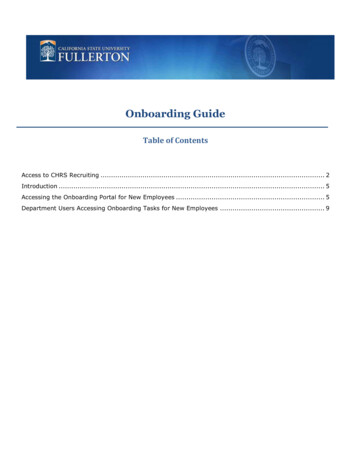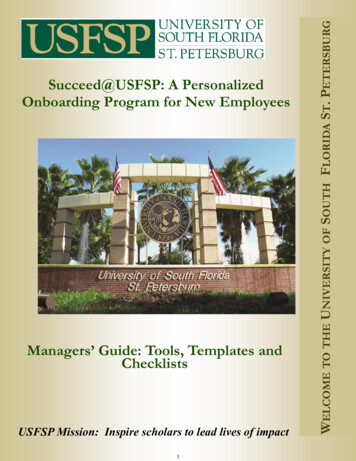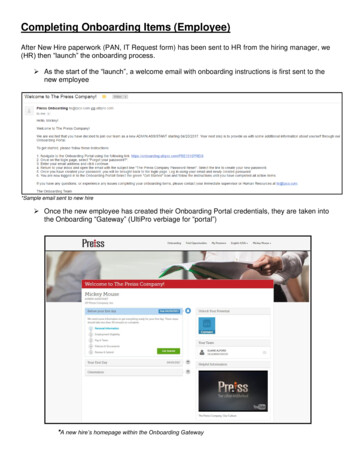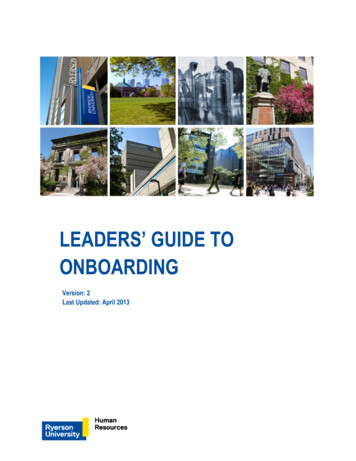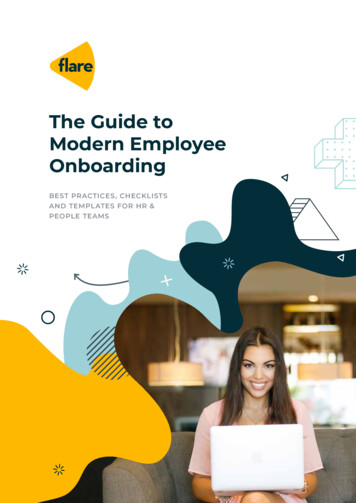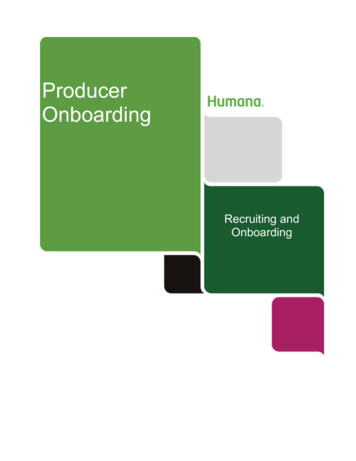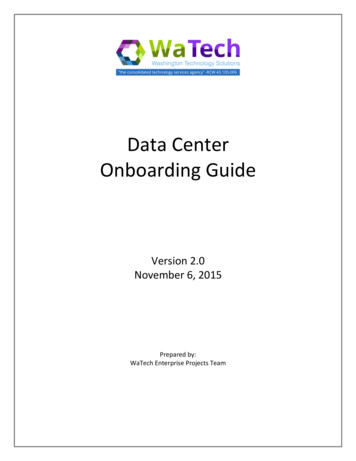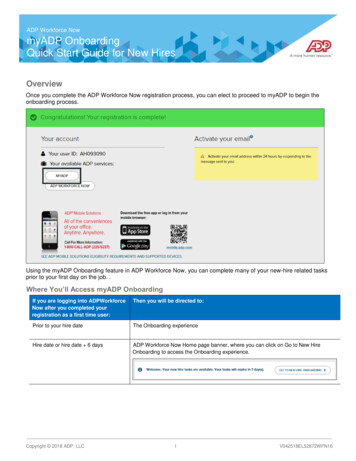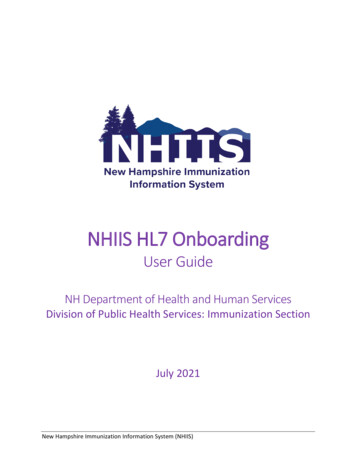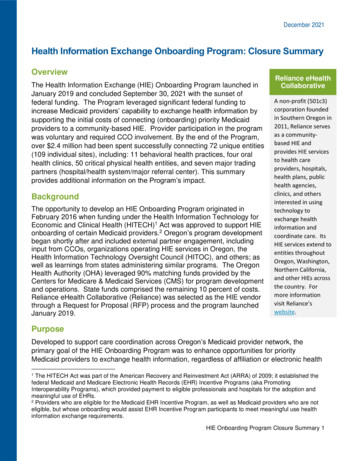
Transcription
December 2021Health Information Exchange Onboarding Program: Closure SummaryOverviewThe Health Information Exchange (HIE) Onboarding Program launched inJanuary 2019 and concluded September 30, 2021 with the sunset offederal funding. The Program leveraged significant federal funding toincrease Medicaid providers’ capability to exchange health information bysupporting the initial costs of connecting (onboarding) priority Medicaidproviders to a community-based HIE. Provider participation in the programwas voluntary and required CCO involvement. By the end of the Program,over 2.4 million had been spent successfully connecting 72 unique entities(109 individual sites), including: 11 behavioral health practices, four oralhealth clinics, 50 critical physical health entities, and seven major tradingpartners (hospital/health system/major referral center). This summaryprovides additional information on the Program’s impact.BackgroundThe opportunity to develop an HIE Onboarding Program originated inFebruary 2016 when funding under the Health Information Technology forEconomic and Clinical Health (HITECH)1 Act was approved to support HIEonboarding of certain Medicaid providers.2 Oregon’s program developmentbegan shortly after and included external partner engagement, includinginput from CCOs, organizations operating HIE services in Oregon, theHealth Information Technology Oversight Council (HITOC), and others; aswell as learnings from states administering similar programs. The OregonHealth Authority (OHA) leveraged 90% matching funds provided by theCenters for Medicare & Medicaid Services (CMS) for program developmentand operations. State funds comprised the remaining 10 percent of costs.Reliance eHealth Collaborative (Reliance) was selected as the HIE vendorthrough a Request for Proposal (RFP) process and the program launchedJanuary 2019.Reliance eHealthCollaborativeA non-profit (501c3)corporation foundedin Southern Oregon in2011, Reliance servesas a communitybased HIE andprovides HIE servicesto health careproviders, hospitals,health plans, publichealth agencies,clinics, and othersinterested in usingtechnology toexchange healthinformation andcoordinate care. ItsHIE services extend toentities throughoutOregon, Washington,Northern California,and other HIEs acrossthe country. Formore informationvisit Reliance’swebsite.PurposeDeveloped to support care coordination across Oregon’s Medicaid provider network, theprimary goal of the HIE Onboarding Program was to enhance opportunities for priorityMedicaid providers to exchange health information, regardless of affiliation or electronic health1The HITECH Act was part of the American Recovery and Reinvestment Act (ARRA) of 2009; it established thefederal Medicaid and Medicare Electronic Health Records (EHR) Incentive Programs (aka PromotingInteroperability Programs), which provided payment to eligible professionals and hospitals for the adoption andmeaningful use of EHRs.2 Providers who are eligible for the Medicaid EHR Incentive Program, as well as Medicaid providers who are noteligible, but whose onboarding would assist EHR Incentive Program participants to meet meaningful use healthinformation exchange requirements.HIE Onboarding Program Closure Summary 1
December 2021record (EHR). “Priority” Medicaid providers were designated as those most salient tointegrated care: behavioral, oral, and physical health providers, as well as hospitals, healthsystems, or multispecialty clinics (major trading partners). See Table 1 for additional details onthose designated as priority Medicaid providers. In an effort to enhance the success of theOregon coordinated care model, participating providers were onboarded according to an OHAapproved work plan Reliance developed in consultation with coordinated care organizations(CCOs). For providers to participate in the Program, CCOs must have established a data,funding, or governance relationship with Reliance. Provider participation was voluntary.By providing an opportunity to Medicaid providers who, in the past, may have been unable toconnect to an HIE due to financial barriers, the HIE Onboarding Program has been integral inhelping move the needle forward on the OHA’s Office of Health IT’s vision of a transformedhealth system where all Oregonians have access to health IT-optimized health care thatresults in better health, better care, and lower costs. Details supporting the progress toincrease priority Medicaid providers’ ability to exchange health information are included in thesection below on Program Participation.Table 1: Priority Medicaid Provider TypesProvider TypeSpecific Provider Types IncludedBehavioralhealthCommunity Mental Health Programs, Certified Community Behavioral Health Centers, BehavioralHealth Homes, Assertive Community Treatment teams, mobile crisis teams, and other statelicensed behavioral health organizationsOral healthClinics and providers serving Medicaid members, including those contracted with managed careentities and those serving fee for service (i.e., open card) populationsCritical physicalhealthMedicaid providers who participate in: Patient-Centered Primary Care Homes, Federally QualifiedHealth Centers (FQHC), Rural Health Centers, Comprehensive Primary Care Plus, tribal health,equity-focused/culturally specific clinics, and county corrections healthMajor TradingPartnersMajor trading Partners include hospitals, health systems, multi-specialty clinics, laboratories, andradiology, especially those that affect the value of HIE for smaller and rural/frontier providersServices DeliveredTwo types of HIE onboarding connections were available to participating providers: a portal (view only) connection, which allows providers to view a patient’s communityhealth record (CHR), and can support providers who do not have an EHR; and an integrated connection, which connects a provider’s EHR to the HIE to allow forseamless exchange of information.Providers who participated in the HIE received financial support from the HIE, as well asfinancial support from OHA to offset their administrative onboarding costs. OHA paid Reliancemilestone-based payments to support new connections to the HIE.HIE Onboarding Program Closure Summary 2
December 2021Program ParticipationTo encourage participation, Reliance conducted outreach across 12 identified regions inOregon (established in collaboration with OHA and based off CCO service areas). Of these 12regions, seven regions yielded OHA-approved work plans, and included participation from 9CCOs with a data, funding, or governance relationship with Reliance. Although seven regionshad approved work plans, HIE onboarding occurred in five regions. Competing prioritiescreated challenges for entities in the Eugene/Springfield and Salem regions to participate bythe program deadline. See Table 2 below for the regions with OHA-approved work plans.Table 2: HIE Onboarding Program Approved Work PlansRegion # & LocationCCOs1: Central OregonPacificSource Central Oregon2. Hood River/The DallesPacificSource Columbia Gorge4. Eugene/Springfield*PacificSource Lane County8. Salem*PacificSource Marion & Polk County9. Southern CoastAdvanced Health & AllCare10. RoseburgUmpqua Health Alliance11. Southern OregonAllCare, Cascade Health Alliance, & Jackson Care Connect*No onboarding completedThe HIE Onboarding Program concluded September 30, 2021 with the sunset of HITECH Actfunding. By the end, over 2.4 million had been spent successfully completing 73 connectionsacross 72 unique entities3 (one entity received both onboarding services). Included in the totalare 109 clinical sites, as well as a hospital in California and a hospital in Washington state thatserve Oregon Medicaid beneficiaries. Of the 73 connections, 24 were portal connections and49 were EHR connections. The 72 unique entities represent: 11 behavioral health organizations4 oral health clinics50 critical physical health entities7 major trading partners (hospital, health system, or major referral center)The most entities onboarded were in Region 11: Southern Oregon, with a total of 24 uniqueentities (25 including the California hospital) successfully connected, followed closely byRegion 10: Roseburg, with a total of 21 unique entities. Reliance attributes the success inthese regions to strong partnerships and collaborative efforts with CCOs. See Table 3 belowfor a breakdown of entities by provider type onboarded for each region. See Figures 1 and 2for a geographical representation of HIE Onboarding Program participation across Oregon forpriority Medicaid provider types.3An entity is a hospital, clinic, health system, organization, solo practice, or other similar group that shares anEHR or other system of managing health and health-related information. Connecting the entity to the HIE willconnect all of its Medicaid Providers to the HIE.HIE Onboarding Program Closure Summary 3
December 2021Table 3: Onboarded Entities by Provider Type per RegionRegionCCOsProvider lHealthMajorTradingPartner1Central OregonPacificSource Central Oregon41100152Hood River/The DallesPacificSource Columbia Gorge402179Southern CoastAdvanced Health & AllCare0031410RoseburgUmpqua Health Alliance101912111SouthernOregonAllCare, Cascade Health Alliance,& Jackson Care Connect231642511450772Figure 1: Onboarded Entities across Oregon: Critical Physical Health and Major Trading PartnersNote: Two out-of-state (CA and WA) major trading partners are not included in this map.HIE Onboarding Program Closure Summary 4
December 2021Figure 2: Onboarded Entities across Oregon: Oral Health and Behavioral HealthSuccessesOHA and Reliance identified several successes as a result of the HIE Onboarding Program,including:The Program significantly expanded HIE connections in five Oregon regionsAt the beginning of the HIE Onboarding Program, Reliance was supporting 191 connections to673 clinical sites across Oregon, including 17 hospitals in five unique health systems and fiveCCOs. By the end of the Program, Reliance was maintaining 327 connections to 1,282 clinicalsites across Oregon, Washington, and in parts of California, including 25 hospitals across 11unique health systems, and nine CCOs. The HIE Onboarding Program contributed 72 unique entities (109 clinical sites) toReliance’s growth. This includes four hospital systems (two out of state) which aremajor data contributors and bring significant value to HIE for the connected clinics andCCOs.HIE Onboarding Program Closure Summary 5
December 2021 The final year of the HIE Onboarding Program, requirements of the 21st Century CuresAct4 promulgated support of the adoption of community-based information exchange,particularly among hospitals and health plans. This encouraged additional interest andparticipation in the Program.The Program supported communities in helping manage patient care during a publichealth crisisReliance has noted renewed interest in HIE across the spectrum of healthcare providersduring the pandemic; in particular, the pandemic has prompted the interest of dental andmental health providers to share information.The Program advanced Health System Transformation goals of coordinated/integratedcare, value-based payment, and supporting populations that face health inequities The Program connected 11 behavioral health and 4 oral health entities, where HITadoption and use falls significantly behind that of physical health providers. Onebehavioral health clinic reported that it depends on the Reliance portal to look up itspatients’ prescribed medications and labs from several other health care entities in theregion, which are vital to patient safety and overall care.The Program connected primary care and behavioral health organizations engaged invalue-based payment.The Reliance Master Patient Index increased 64% during the years the HIE OnboardingProgram was operational (2019 – 2021)The Program connected large and small organizations, including critical health careorganizations for communities and populations that are likely to face health inequities:o 29 Patient Centered Primary Care Homes (two also qualify as Federally QualifiedHealth Centers)o Two Comprehensive Primary Care Plus clinicso Two tribal health clinicso Two Community Mental Health Programso One Rural Health Clinico One county correctional organization: This is particularly significant becauseincarceration often leads to gaps in the exchange of health information,coordination of care, and worse health outcomes. By onboarding to Reliance,providers at the correctional facility will be able to view health information fromparticipating entities (within the community health record), for individualsincarcerated at their facility. This will result in more informed care and supportbetter health outcomes for the individual.See Figure 3 below for a comparison of specific provider types onboarded under theHIE Onboarding Program.4The 21st Century CURES Act Final Rule implements interoperability requirements that prohibit health careproviders from information blocking and empower patients to have more access to their health information.HIE Onboarding Program Closure Summary 6
December 2021Figure 3: Onboarded Provider Types within Priority CategoriesThe Program made a major impact on CCO HIE strategies and supplemented significantHIE investments from CCOs The Program served to incentivize CCOs considering whether to participate in Relianceas part of their regions’ HIE strategy. Two CCOs in new regions (Roseburg andSouthern Coast) joined Reliance during the Program and leveraged it to onboard clinicsand hospitals.CCOs have found the Program to be very useful in supporting care coordination in theirservice areas. As a result, three CCOs requested the state seek funding to continue theProgram beyond September 30, 2021. Examples of the impact of the HIE OnboardingProgram for CCOs include:o One CCO included requirements in oral health provider agreements tomeaningfully engage in the HIE Onboarding Program.o One CCO is working on integrating Reliance HIE with a tool to enhance thesharing of care plans and aims to have 50% of its network providers live onReliance by 2023.o One CCO helped providers in one county move from a shared clinical patientrecord to a variety of electronic medical records and leveraged the HIEOnboarding Program information exchange between 20 entities in the area. ThisCCO also provided financial incentives to providers who completed onboarding.HIE Onboarding Program Closure Summary 7
December 2021Challenges and Lessons LearnedIn the nearly three years of its operation, the HIE Onboarding Program gave rise to severalsuccesses; however, there were also challenges that surfaced, giving way to lessons learnedon HIE in Oregon and valuable insight for potential future programs.Timing issues created participation barriers for providers and CCOs HITECH Act funding for HIE onboarding ended September 30, 2021. The limitedfunding period created a short timeline to maximize Program potential.OHA re-procured CCO contracts in 2019, and CCO new contracts came into effectJanuary 1, 2020, meaning many CCOs were focused on contracting and had a smallerwindow to take advantage of the HIE Onboarding Program. Most CCOs were not ableto participate until later in the program, which inhibited the number of priority MedicaidProviders that could be onboarded.The COVID-19 pandemic shifted resources and priorities for providers and CCOs.Program outreach and education efforts were halted or reduced to relieve burden onproviders as they focused on patient care needs.In early 2021, the HIE Onboarding Program was scheduled to end June 30 due to afunding shortfall as a result of state budget reductions. During the 2021-23 legislativesession, OHA was able to secure additional funding to continue the Program through itsoriginal end date, September 30. Although the final quarter of operations saw moreconnections, the risk of an early conclusion paused outreach to potential participants.These timing issues contributed somewhat to lower rates of participation. Prior to thedeadline, five hospitals began participating; however, these entities were unable tocomplete onboarding by the deadline due to competing priorities and timeline delays.Fortunately, the value of the Program and the recent federal legislation aroundinteroperability has motivated providers to continue onboarding, even without the benefit offederal and state funding.OHA should consider future opportunities to provide incentivesEven though there is not a current funding opportunity to leverage, OHA will continue to lookfor any opportunities that may arise. OHA staff found that incentivizing onboarding provides anopportunity to support providers serving Oregon’s most vulnerable populations who wouldprefer to participate in HIE but face financial barriers. Moreover, state involvement can helpensure EHR vendor neutrality and a focus on providers whose HIE onboarding would have themost impact on improving care coordination.ContactFor questions about the HIE Onboarding Program, please contact Jessi Wilson atJessica.L.Wilson@dhsoha.state.or.usHIE Onboarding Program Closure Summary 8
2 Providers who are eligible for the Medicaid EHR Incentive Program, as well as Medicaid providers who are not eligible, but whose onboarding would assist EHR Incentive Program participants to meet meaningful use health information exchange requirements. A non-profit (501c3) corporation founded in Southern Oregon in 2011, Reliance serves

